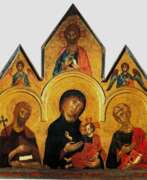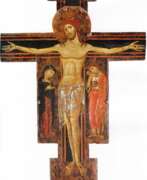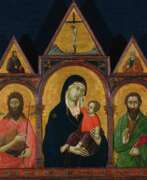Painters 13th century


Cimabue, a preeminent Italian painter and mosaicist from the late 13th century, remains a pivotal figure in the transition from the Byzantine to the early Renaissance art style. Born before 1251 and passing in 1302, his works are celebrated for their innovative departure from the Italo-Byzantine conventions, introducing more naturalistic forms and expressions into Western European painting. This transformative approach is evident in his frescoes in the Basilica of San Francesco, Assisi, and the Santa Trinita 'Maestà' now housed in the Uffizi Gallery, Florence.
Cimabue's significance in art history is underscored by his role in laying the groundwork for the evolution of Italian painting, marking a critical moment when artists began exploring the depiction of three-dimensional space and the naturalistic rendering of forms. His influence extended to his contemporaries and successors, notably Giotto, who is often credited with advancing the Renaissance style that Cimabue initiated.
One of Cimabue's most notable works, the Santa Trinita 'Maestà', exemplifies his mature style with its refined use of perspective and more humanistic portrayal of figures, moving away from the rigid Byzantine models. This painting, alongside his frescoes in Assisi and the mosaic of 'Saint John the Evangelist' in Pisa's cathedral, demonstrates his pioneering role in the early Italian Renaissance. Despite being eventually eclipsed by Giotto, Cimabue's legacy as a bridge between Byzantine traditions and the nascent Renaissance cannot be understated.
Cimabue's artwork not only represents a crucial pivot in art history but also continues to captivate collectors and experts in art and antiques for its historical significance and the foundational role it played in the development of Western art. For those keen on exploring the origins of Renaissance art, Cimabue's works offer invaluable insights into the period's artistic evolution.
For aficionados and connoisseurs deeply engaged in the realms of art history and antique collection, particularly those with a keen interest in the seminal period that bridges the Byzantine and Renaissance eras, staying informed on Cimabue's artistic legacy is invaluable. To this end, we cordially invite you to subscribe to our dedicated updates. This subscription service is designed to provide enthusiasts with exclusive notifications about new discoveries, forthcoming sales, and prestigious auction events directly related to Cimabue's remarkable oeuvre. Engage with us to ensure you remain at the forefront of significant developments and opportunities to enhance your collection with works from this foundational figure in art history.


Giotto di Bondone, an Italian painter and architect, emerged as a pivotal figure in the transition from medieval to Renaissance art. His mastery in painting is best exemplified in the Scrovegni Chapel in Padua, also known as the Arena Chapel, where his fresco cycle depicting the Life of the Virgin and the Life of Christ is considered a seminal work of the Early Renaissance. This chapel, completed around 1305, highlights Giotto's innovative approach to art, breaking away from the Byzantine style that dominated the period. His techniques in depicting life and emotion in his works were revolutionary, setting a new direction in Western art.
Despite his acclaimed works, many aspects of Giotto's life remain shrouded in mystery and controversy, including his exact birthplace and the full extent of his apprenticeship. Traditionally believed to have been born in a farmhouse in either Colle di Romagnano or Romignano, recent research suggests he was born in Florence, the son of a blacksmith. His birth year is also uncertain, with estimates ranging from 1266/67 to 1276.
Giotto's early life, as narrated by Giorgio Vasari, is filled with anecdotal charm. He was supposedly discovered by the renowned Florentine painter Cimabue while drawing pictures of his sheep on a rock, so lifelike that Cimabue immediately recognized his talent. This encounter led to Giotto's apprenticeship under Cimabue, although this story, like many others about his early life, is debated by scholars.
In addition to the Scrovegni Chapel, Giotto's notable works include the decoration of various chapels and churches across Italy, such as in Assisi, Rome, Florence, and Naples. His Crucifixion panel and the Nativity scene are particularly celebrated for their depth and emotional intensity. Giotto was also an architect; in 1334, he was chosen to design the campanile of the Florence Cathedral, reflecting his reputation as a foremost artist.
Giotto's influence extended beyond his lifetime, inspiring future Renaissance artists with his naturalistic representation of human figures and his skill in conveying perspective and emotion. His works in the Peruzzi Chapel in Florence, particularly the Life of St. John the Baptist, are examples of this legacy.
In summary, Giotto di Bondone stands as a monumental figure in art history, his contributions marking the dawn of the Renaissance and forever altering the course of Western art. His ability to infuse his works with realism and emotional depth set a new standard in artistic expression, influencing generations of artists to come.
For those interested in the art and history of Giotto di Bondone, updates on new product sales and auction events related to his work are available. Sign up to stay informed about these opportunities and to deepen your appreciation of this pivotal artist's legacy.


Duccio di Buoninsegna, a master Italian painter from the late 13th and early 14th centuries, is celebrated as a pivotal figure in the Sienese school of painting. His birth and career in Siena profoundly influenced Italian medieval art, especially through his integration of the Italo-Byzantine tradition's formality with the Gothic style's emerging spirituality.
Duccio di Buoninsegna’s artworks are predominantly wood panel paintings, utilizing egg tempera and gold leaf, reflective of the period's artistic practices. His innovative approach is noted for its delicacy and precision in tempera, a marked contrast to the techniques of his contemporaries. Duccio di Buoninsegna is credited with softening the rigid lines of Byzantine art, rendering figures more rounded and three-dimensional, and employing modeling to enhance light and shadow effects, lending depth and realism to his subjects.
Among Duccio di Buoninsegna’s most significant works are the "Rucellai Madonna" at the Galleria degli Uffizi and the "Maestà", an altarpiece for Siena Cathedral. These dated and major public commissions, particularly the Maestà, created between 1308 and 1311, stand out as extraordinary achievements. The Maestà is a large and complex altarpiece, painted on both sides with about eighty separate scenes, showcasing Duccio di Buoninsegna’s intricate and detailed style.
Duccio di Buoninsegna's influence extended to numerous artists, including Simone Martini and the brothers Ambrogio and Pietro Lorenzetti. He had several followers, ranging from actual pupils in his workshop to artists simply inspired by his style. This includes artists from the first generation of followers active between 1290 and 1320, and a second generation active between about 1300 and 1335. His influence continued to shape Sienese and Tuscan painting well after his death.
For art collectors and experts, Duccio di Buoninsegna’s work represents a critical moment in Western art's evolution. His nuanced approach to religious themes and pioneering techniques make his works highly valued in the art and antiques world.
If you are passionate about the history and works of Duccio di Buoninsegna, consider signing up for updates. This subscription will keep you informed about new product sales and auction events related to Duccio di Buoninsegna's art, ensuring you stay connected to the legacy of this remarkable Sienese master.


Master Badia a Isola (Italian: Maestro di Badia a Isola) was an Italian anonymous painter of the Sienese school who worked in and around Siena in the late 13th and early 14th centuries.
The conditional name of the master comes from the large icon "Madonna on the throne with a child and two angels" (Maesta), which used to be in the church of St Salvatore and Sirin in Badia a Isola in Monteriggioni.
Researchers believe that the Master of Badia a Isola belonged to the inner circle of the great Duccio di Buoninsegna, and was in the first rank of his pupils and followers. It is assumed that he worked in the workshop in the early period of Duccio's work. His works have direct parallels with those of Ugolino di Nerio, especially in the delicate contours of the figures and the sweet faces of the Madonnas.



























































